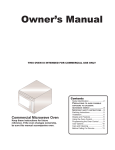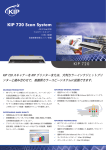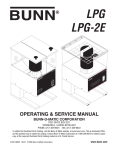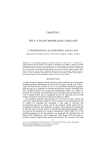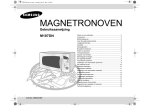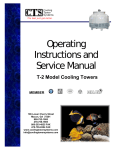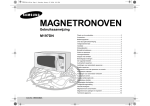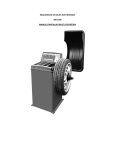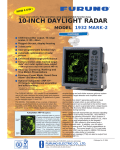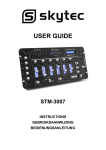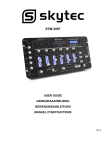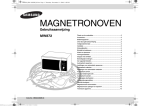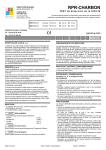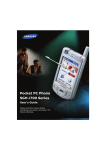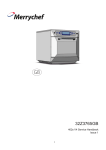Download KR-1338/1668 SERVICE MANUAL
Transcript
KR-1338/1668 KR-1338/1668 SERVICE Î ¬ Ê Ð Ö ÞMANUAL ² á 10.4 TFT COLOR MARINE RADAR TABLE OF CONTENTS 1.GENRAL 1.1 Outline 1.2 Boards & Major Components 1.3 Specifications 1 1 2 3 2.BLOCK DESCRIPTION 6 2.1 Overview 2.2 Display Unit Block Diagram of Power Supply Block Diagram of Processor PCB Main 0910 2.3 Transceiver Unit Block Diagram of IF 0711 Block Diagram of Modulator 2.4 Different Points of Similar PCBs 3. ADJUSTMENT 3.1 Adjustment of Display Unit Location of Parts on MAIN 0910 VIDEO Signal adjustment Location of parts on PWR-0913 3.2 Adjustment of Scanner Unit Location of parts on MOD-0904 Location of Parts on IF-0711 Location of PCBs in Transceiver Module (KR-1668) BEARING SIG GEN Board (HBP0904) Location of Parts on MOD 0904B Location of Parts on IF-0711 4. MAINTENANCE 4.1 Remarks on Replacement of Major Parts 4.2 Life Expectancy of Expendable Parts 4.3 Menu tree 6 7 9 10 14 15 17 18 19 20 24 25 28 29 30 31 32 32 33 34 35 35 36 37 5.TROUBLESHOOTING 5.1 Outline 5.2 Troubleshooting Flow Charts 5.3 Message Indication 38 38 39 51 Display Unit Exploded view 52 Scanner Unit Exploded View 54 Schematic circuit diagram 58 1. GENERAL 1.1 Outline This manual provides the information necessary for the servicing and adjustment of the radars MODEL 1338, 1668. The antenna unit uses a Log IF amplifier. The table below shows the major specifications of the each model. The same program is installed on all models, but the menu setting through factory menu is different between the models. Functions KR-1338 KR-1668 Maximum range 36 NM 64 NM Program Number 1002XX Tuning Voltage (displayed at manual tuning) 4.9 V to 32V Antenna Rotation about 24 rpm Antenna Rotation 4 kW XX 4/6 kW KR-1338-SME-1 The major parts and P.C. Boards used in the display and scanner units are tabulated on the next page. 1 1.2 Boards & Major Components Board DISPLAY UNIT KR-1338 KR-1668 PROCESSOR Board MAIN 0910 POWER SUPPLY Board PWR 0913 FILTER Board FIL 0912 PANEL Board KEY 0912 MODULATOR Board MOD 0904A MOD 0904B IF AMP Board RTB Board SCANNER UNIT BEARING SIG GEN Board MIC Board IF 0711 - HBP 0905 RCN 0907 NJT-1968B MIC Cable CON 0906 Magnetron MAF1421B/MSF1421B Circulator FCX73C Scanner Motor BM-9256 Signal Cable MAF1421/MAF1422B BM-8256 KRC-003-10(10m) KRC-003-15(15m) KRC-003-20(20m) KRC-003-30(30m) KR-1338-SME-2 2 1.3 Specifications SCANNER UNIT KR-1668 KR- 1338 Radiator Type Slotted Waveguide Array Radiator Length 56cm 120 cm Horizontal Beamwidth 4 1.9 Vertical Beamwidth Within 20 Sidelobe of mainlobe Attenuation Outside 20 of mainlobe Polarization 20 22 -18 dB or less -24 dB or less -23 dB or less -30 dB or less Horizontal Antenna Rotation 24 rpm nominal Scanner Housing Stureruct Radome Open nominal Compass Safe Standard Distance Steering 0.9 m 1.0 m 0.7 m 0.74 m KR-1338-SME-3 TRANCEIVER KR-1338 KR-1668 Magnetron MAF1421B/MSF1421 MAF1421/MAF1422B Frequency &Modulation 9410 M Hz Peak Output Power 4 kW nominal Pulse Length & Pulse Repetition Rate 30M Hz,P0N 6 kW nominal 0.08 S, approx 2100 Hz Short Ranges:0.25 nm -1.5 nm) 0.3 S, approx 1200 Hz(Middle Ranges: 1.5nm - 3nm) 0.8 S, approx 600 Hz(Long Ranges: 3 nm and above) Modulator FET Switch Duplexer Circulator with diode limiter Receiver Front End Tuning MIC(Microwave IC) Automatic or Manual Intermediate Frequency 60 M Hz Bandwidth 25 MH z(0.08 S, 0.3 S), 3 M H z (0.8 S) KR-1338-SME-4 3 DISPLAY UNIT KR- 1338 10.4 LCD(LED backlight ,32 bit TFT color LCD) Picture Tube KR-1338:36 nm KR-1668:64 nm Range Scale(nm) 0.125 0.25 0.5 0.75 Range Ringe Interval Number of Rings Bearing Resolution KR-1668 1 1.5 2 3 4 6 8 12 16 24 36 48 64 1/16 0.125 0.125 0.25 0.25 0.5 0.5 1 1 2 2 3 4 6 12 12 16 2 2 4 4 3 4 3 4 3 4 3 4 4 4 4 3 4 4 1.9 Range Discrimination Better than 20 m Bearing Accuracy 1 Better than 25 m Minimum Range Range Ring Accuracy VRM Accuracy Input/Output Terminal 0.9 or 8m,whichever is the greater NMEA (three input): NMEA 0183 NMEA (output) :NMEA 0183($RATLL, $RARSD, $RATLL: Internal easy ARPA version.) External Buzzer (output) : +12 V source pulse Open Collector Slave Display (output): TRU-HD, BP, TRU-TRIG, VIDEO Nav Data Compass safe Standard Distance Steering NMEA 0183 Format ( :any talker) $ APB, $ BWC, $ BWR, $ D PT, $ GGA, $ GLL, $ GLC, $ GTD, $ HDG, $ HDM, $ HDT, $ MDA, $ MTW, $ RMA, $ RMB, $ RMC, $ VTG, $ VHW, $ XTE, 0.75 m 0.6 m KR-1338-SME-5 4 ENVIRONMENTAL CONDITIONS KR-1338 Ambient Temperature Scanner Unit -25 to +70 Display Unit -15 to +55 Humidity Relative humidity 93% Vibration -IEC 60945 KR-1668 2% or less at +40 3 KR-1338-SMJ-6 POWER SUPPLY & POWER CONSUMPTION KR-1338 KR-1668 10.5 V to 40.0V DC Power 48 W approx 56 W approx KR-1338-SME-7 5 2. BLOCK DESCRIPTION 2.1 Overview The simpified block diagram of the system is illustrated below. Scanner Unit Antenna Display Unit Mag. MIC Mod. IF Amp HD.BP Video Trigger Processor LCD RF Module Panel Power Ship ' s mains Nav. Gyro TX The trigger pulse from the PROCESSOR Board is delivered to the MODULATOR Board, oscillates the magnetron, and then radar wave is emitted from the radiator. RX The 9.4 Ghz echo signal received by the antenna is converted to 60 Mhz signal by the MIC, amplified by IF Amp, and fed to the PROCESSOR Board as video signal. It is digitally processed and then displayed on the LCD. 6 2.2 Display Unit Power Supply Circuit (PWR 0913) The constant voltage generator Q1 is in operation even when power switch is off, ship's mains is supplied. The power supply circuit is basically consists of a main inverter and a sub inverter. The main inverter derives the isolated line voltages +12 V/ANT+12 V and -12 V/ANT -12 V from the main input. The sub inverter derives +5 V and +32 V from +12 V output of the main inverter. Main inverter The PWR switch becomes "open" when it is set to on position. When the PWR switch is pressed, about 9 V is input via PWR line (P1302 #13), Q2 is on, and DC+10 V is applied to the PWM. When power is supplied to the PWM controller, it starts operation and alternately turns on and off two switching FETs Q3/Q4 connected to the primary widing of T1. The resultant AC voltage obtained on the secondary windings are rectified and smoothed to +12 V and -12 V, and delivered to various circuits in the equipment. The voltage taken from the +12V line is fed back to the PWM controller through the Vr1 to maintain the +12 V output constant. Sub inverter U5 and the associated circuit form a PWM switching regulator for +5V and +32V. The voltage taken from +5 V line is fed back to U5 through R37 resistance to maintain the +5 V output constant. Protectors Protection of power supply circuit is achieved by stopping the drive signals to the switching FETs Q3/4. 7 Qverload on +5 V and + 32 V line is detected by U6. Overload on +12 V(MOTOR+) line is detected by U7. When the +5 V and + 32 V line is reduced by a heavy load, U6 or U7 becomes condctive and consequently disables the PWM controller through Q6, Q7 and Q8. Overcurrent on the main input line is detected by R13, R14 and R15. The voltage drop across Q6, Q7 and Q8 bec- omes large when the inverter is overload. Overcurrent detector U3 disables PWM inverter U2 when the voltage drop exceeds a certain level. Overvoltage of mains input is detected by the U1. When the input voltage exceeds 41.6 V, the U1 becomes active and disables PWM controller U2 Scanner motor power (ANT+12V/ -12 V) +12 V and -12 V (ANT +12 V/ANT -12 V) are used to drive 24 V scanner motor. The power to the motor is turned on/off by the relay(K1) on the POWER SUPPLY Board. The relay control signal from the SPU Board is supplied to Q52 and Q53 on the POWER SUPPLY Board. Pressing the TX key changes the ANT SW signal state from 5 V to 0 V, and K1 is on to supply +12V. . 8 BLOCK DIAGRAM OF POWER SUPPLY 9 BLOCK DIAGRAM OF PROCESSOR PCB MAIN 0910 10 AUTOMATIC TUNING There are two types of automatic tuning: peak search and short search. The tuning voltage differs from model to model. KR-1338/1668 : 5 V to 28 V Peak search: Tuning voltage (TUNING), point in the figure below, is searched in the tuning voltage range 5V to A 28V. Tuning Indicator voltage (TUNING IND) is maximum at point . Search conditions: After initial tuning adjustment. Search time: 3 sec approx Short search: Maximum tuning indicator voltage A is searched in the tuning voltage range of 2.5V. A initial tuning adjustment. 1)After 2)When tuning method is switched from manual to automatic. 3)When the radar is switched from ST-BY to TX. 4)When a range where pulselength is changed from short to middle and from middle to long is selected. Tracking: After short search, tracking takes place. Tracking voltage: 0 V to 32 V KR-1338/1668 11 TUNING INDICATOR After tuning adjustment, peak TUNING IND voltages, , and on page 2-5 are stored on to EEPROM. in the figure The automatic and manual tuning point A is also memorized. Using these data, the tuning indicator extends more than 80% on ALL TX pulses. Note that the extension on short pulse is shorter than on long pulse. The indication becomes shorter with the magnetron deteriorated. MANUAL TUNING The manual tuning voltage changes from 5 to 32 V on M 1668 at the steps of about 0.1 V. Manual Tuning is carried out by using omnipad: pressing "Right" side increases. The TUNING continue voltage displayed on the screen differs by about 1V from the measured voltage at P52 # 9. Manual Tuning and tuning adjustment are required when automatic tuning is abnormal (that is ,low sensitivity). CVT FROM PANEL BOARD P8 P/S CONV. CPU D/A CONV. #5 #7 U2 #10 FVT U9 U27 U20 #3 #8 P8 TUNING CONTROL (TO RF UNIT) #1 TUNING CONT. Operation (from power-on stand-by) A square wave is automatically output as a TUNING CONT signal during standby just after power-on the model as follows. F VT 34V 5V C VT 0V KR-1838/1968/1948 12 Heading and NAV data Heading data in NMEA format HEADING DATA (HDT, HDG, HDM, VHW)and NAV data (NMEA-0183)can be input from any NMEA input connection. THE data from the KEY board(KEY 0912) to P8#3 of MAIN board . NOTE: 1.If only one NMEA signal input may select any connection, if several connections have time the signal input, be please main and the most commonly used signal meets in the connection 1, because the complete signal's input is 1 comes the synchronization by the connection, i.e. the connection 1 signal is fastest; 2.The NMEA signal after or before radar starting in may, but in signaling process, if the NMEA port 1 loss of signal, will possibly cause other port data not to be able to transmit normally. Must remove this kind of condition only to be able again starting. Turning on/off antenna rotation The SPU board controls antenna rotation. In normal operation, the antenna rotates during the TX condition. However, the antenna can be stopped during the TX condition thru the Installation setup menu. 13 2.3 Transceiver Unit MIC The following description is for reference only. As a general rule of thumb, the radar requires better noise figure (NF) and better dynamic range. Both factors, however, are reciprocal. The NF affects long range performance, while the dynamic range dose short range performance. To improve noise figure, amplifier and MBS circuit into the MIC, RU-9360. MIC w/RF amplifier RF IN W.G.TO COAX CONV. GND NJT-1968B(MODEL 1338/1668) LIMTER FET AMP DOUBLEBALANCED MIXER POWER FET OSC. (+5V) (+5V to 35V) Block Diagram of MIC NJT-1968B (MODEL 1338/1668) 14 IF OUT BLOCK DIAGRAM OF IF 0711 15 Modulator PRINCIPLE OF FET SWITCHING MODULATOR High voltage is charged into C through R while the magnetron is inactive. When the trigger is applied to the power MOS-FET, the FET turns on and the high voltage appears at the primary winding of the pulse transformer. This transformer boots the voltage, which makes the magnetron oscillate. One advantage of this method is that the magnetron oscillates only when the FET is conducive, that is the transmission pulsewidth can be changed by the TX trigger pulsewidth. Therefore, parts such as relay and coil can be eliminated. R Charge PULSE TRANS C Discharge MAGNETRON D MOST-FET HIGH VOLTAGE TRIGGER Modulator section simple block diagram MODULATOR BOARD MOD-0904 The main function of the modulator section is to produce high voltage pulses to drive the magnetron. To produce these pulse, the MODULATOR Board has a modulator trigger circuit, modulator pulse generator and booster pulse transformer. The modulator trigger circuit consists of U805 and associated components. This circuit generates the pulses which cause modulation FETs Q805,Q806 to conduct. The pulses are produced when the TX TRIG pulses from the display unit is received and U805 conducts. The voltage of the pulses is raised at pulse transformer T802 until it is 3.5 kV. This circuit adjusts the electrical curent flowing into the magnetron so it is 3 A. The MODULATOR Board also contains the TX high voltage circuit and the magnetron heater circuit. The TX high voltage circuit charges capacitors with 300 V high voltage produced at the primary windings of T801 and discharges them once the TX TRIG pulse is received. The magnetron heater circuit produces stable +7.5V. 16 BLOCK DIAGRAM OF MODULATOR PCB MOD 0904 17 2.4 Different Points of Similar PCBs 1. How to set SPU (MAIN 0910) Board This board is set at factory for use in the KR-1338. For use in the or 1668, change the factory menu as below. While pressing and holding down the GAIN(HM-OFF) control, press the [MENU] key five times to display the factory menu. [Factory MENU] 1. Max Range 2. Typ e 3. Model 4. Language 36 48 64 R G N K KR-1338 KR-1648 KR-1668 ENG CHN 5. Default Setting ENTER 3 <Press MENU key to escape > M1338-SME-09D 1) MAX range 36 nm: KR-1338, 48 nm: KR-1648, 64nm: KR-1668 2) Type R: Regular, G: German, N:Netherland, K:Korea 3)Model Selects the Antenna Unit. KR-1338 KR-1648 KR-1668 4)Language CHN: Chinese English 5)Default Setting Default settings (except factory menu) can be restored by selecting Default Setting and pressing the [ENTER] key three times. Restart radar settings. After changing the setting, the installation adjustment (heading, timing, etc.) Must be carried out again. 2.MODULATOR board MOD-0904 A/B E version of MOD-0904 is not compatible with A version. This is because B has a larger pulse transformer. 18 3. ADJUSTMENT WARNING IMPORTANT! SAFETY INFORMATION Be sure to read all the safety information which follows before perfoming any adjustment. Hazardous Voltage This equipment uses high voltage electricity which can SHOCK, BURN or cause DEATH Always make sure the electrical power is turned off before attempting to change a component or inspecting the inside of the equipment. A residual charge may exist in capacitors, even with the equipment turned off. Always short all supply lines to the chassis with an insulated screwdriver or a similar tool before touching the circuit. Working on the Scanner Unit Mast Work on the scanner unit mast in dangerous, and doubly so if the proper precautions are not taken. 1. Post an appropriate warning sign near the display unit to indicate that work on the scanner unit is being performed, to prevent accidental application of the power to the scanner unit. 2. Wear a safety helmet and always be aware of where the scanner radiator is. 19 3.1 Adjustment of Display Unit Display Unit, Front side of view Power Connector GND OPTION DJ-1 Connector Fuse Holder UPGRADE GND NMEA-1 Connector GND NMEA-2 Connector Display Unit, Rear side of view 20 Inside of Display Unit, LCD Inside of Display Unit, Processor PCB 21 Inside of Display Unit, Power PCB 22 Line Voltage Item Ratings Test Point Remarks +12 V 12.1 to 12.3 V DJ1-10(+)-DJ1-20(-) +5 V 4.9 to 5.1V DJ1-23(+)-DJ1-20(-) +12 V -11.6 to -12.8 V DJ1-14(+)-DJ1-20(-) ANT 12 V 12.0 to 12.3 V DJ1-1(+)-DJ1-20(-) ST-BY KR-1338-SME-8 Output signals from DJ-1 connector Test Item TUNE P/L A P/L B Ratings Approx. 5 V to 28 V(KR-1338/1948/ 1968) Short pulse: 0 to 1.0V(L) Medium pulse:7 to 12 V(H) Long pulse: 7 to 12 V(H) Short pulse: 0 to 1.0V(L) Medium pulse:0 to 1.0 V(L) Long pulse: 8 to 12 V(H) Test Point Remarks DJ1-6(+) -DJ1-20(-) Antenna Unit disconected TX, Auto tuning DJ1-8(+) -DJ1-20(-) Antenna Unit disconDJ1-7(+) -DJ1-20(-) ected Tx condition Short pulse: 2000 to 2300 Hz DJ1-2(+) -DJ1-20(-) TRIGGER Pulsewidth: 10 to 20 s (All range) Polarity: Positive Polarity 8 to 12 V(H) KR-1338-SME-9 23 Location of parts on MAIN 0910 VR3 TP6 VR1 VR2 TP2 TP1 TP3 TP4 TP5 MAIN 0910 Board Test Point on MAIN 0910 Tes t Point Test Item Ratings TP1 TRIGGER 3.3 Vpp TP2 VIDEO -4 Vpp TP3 Gain level preset TP4 STC Curve TP5 VIDEO Preset 4 S: 1.0V to 1.2V 20 S: 2.0V to 2.3V 40 S: 2.6V to 2.8V 60 S: 3.0V to 3.2V 90 S: 4.0V to 4.5V Remarks TX Condition TX Condition GAIN VR: MAX STC VR: MAX -4 Vpp (Neg. Polarity, main bang level) TX Condition TP6 TX TRIGGER 8 to 12V KR-1338-SMC-10 24 VIDEO Signal adjustment VIDEO signal adjustment is carried out in the processor board. This is a simplified block diagram of the video amplified circuit. VIDEO AMP J52 VIDEO IN Clutter level TP7 <2 ANTI-LOG Video level TP5 Gain preset TP3 Video Out TP2 VR3 VR1 VIDEO LEVEL GAIN PRESET STC Curve TP4 A/C RAIN, GAIN A/C SEA JS2 BEARING P 3 STC HEADING P 4 Check Point STC TRIG A/C AUTO STC CURVE SCAN Video level 12V VR2 JS2 Conditions A/C AUTO OFF A/C SEA fully counterclockwise A/C RAIN fully counterclockwise TX on 12 nm Table 3-5 video level Rating TP5 on SPU pcb (trigger at TP1) Adjuster VR3 V 1 = 500 to 700 mV V 2 = 4.2 0.2V 25 Conditions A/C AUTO A/C SEA A/C RAIN GAIN Scanner Gain preset OFF fully clockwise fully counterclockwise fully Clockwise OFF [INSTALLATION SETUP 1] menu 4. Ant on Tx : STOP Table 3-6 Gain preset Check Point Adjuster Rating VR1 TP3 on SPU pcb (trigger at TP1) V = 0.04 to 0.06V Conditions STC curve A/C SEA GAIN TX on 12nm fully clockwise fully Clockwise Table 3-7 STC curse Ant Height on Installaion Setup menu Check Point Rating at 60 uS point TP4 3.1 0.1V 3.6 0.2V 2.5 0.2V 60uS 26 MED LOW HIGH Adjuster VR2 ANT height setting Antenna height (STC curve adjustment) should be set Radar at installation to match the STC curve with installation conditions. This is especially important when sea conditions changes over time - rotation of the STC VR may erase both sea clutter and legitimate targets if the STC curve is not suitable. Setting in the field 1. Set antenna height on the Installation Setup 1 menu If both sea clutter and echoes disappear, decrease antenna height setting. If sea clutter cannot be completely eliminated, increase antenna height setting. 2. Adjust Vr2 on the SPU board. If both sea clutter and targets disappear: increase voltage at 60 us point. Note: The following step, adjustment of the STC, should only be followed when step 1 and 2 do not produce satisfactory results. Record the factory setting before adjusting the STC. 3. Adjust STC. (Press the MENU key five times while pressing and holding down the HM OFF control to display the FACTORY menu. Operate the trackball to change the maximum effective range of the STC. 27 Location of parts on PWR-0913 TP32 TP2 TP31 TP1 TP3 TP4 Test point on PWR-0913 Test Point Test Point TP1 +10 V TP2 DC(-) Test Point 8.2 to 9.5 V - TP3 Inverter Frequency 85.5 to 94.5 KHz VR No Remarks - - - - - - VR 1 - TP4 J1 J1 J1 J1 TP 31 +12 V 12.1 to 12.3 V TP 32 +5 V 4.9 to 5.2 V - - +12 V -11.6 to -12.8 V - - +32 V 30.0 to 35.0 V - - #2(-) #7(GND) #3(+) #7(GND) KR-1338-SME-11 28 3.2 Adjustment of Scanner Unit Location of PCBs in Scanner Unit KR 1338 MIC (NJT1968) Magnetron V801 MSF1421 MODULATOR MOD0904 Read Swith S801 IF AMP Board IF0711 Scanner Motor B801 BM-9256 Inside of Scanner Unit 29 Location of parts on MOD-0904A TP802 TP801 VR801 VR802 TP803 Test point on MOD-0904 A Test Point Test Item Ratings VR No TP 801 TRIGGER Same as MAIN 0910 TP6 in Display Unit - TP 802 GND - - - ST-BY: 300 to 370 Vdc TX: 290 to 330 Vdc(Long) - - - - - #1 TX-HV #2 GND TX Condition TP803 #3 +14V 13 to 17 Vdc #4 Mag. Heater 7.4 to 7.6 Vdc #5 0.25 to 1.2 Vdc(Short) Mag. Current 0.7 to 1.2 Vdc(Medium) 0.9 to 1.1 Vdc(Long) #6 GND - - ST-BY VR801 ST-BY VR802 TX (Long) Condition - KR-1338-SMC-12 30 Location of parts on IF-0711 TP1 TP5 TP7 TP8 TP9 TP3 TP10 Test point on IF-0711 Test Point TP 1 TP 3 Test Item Ratings Center Frequency For factory adjustment correction Same as MAIN 0910 TP5 VIDEO output in Display Unit VR No Remarks T1, T2 - - - T3, T4 - TP 5 Tuning indicator For factory adjustment TP 7 +9 V 8.7 to 9.3 Vdc - - TP 8 +5 V 4.7 to 5.3 Vdc - - TP 9 -9 V -8.7 to -9.3 Vdc - - TP 10 -5 V -4.7 to -5.3 Vdc - KR-1338-SME-13 31 Location of PCBs in Transceiver Module (KR-1668) IF MAP Board IF0711 MIC U801 Magnetron V801 Transceiver Module BEARING SIG GEN Board HBP0904 TP803 J701 MODULATOR Board MOD0904 J812 J811 Transceiver Module, Cover removed 32 Location of Parts on MOD 0904B TP801 TP802 TP803 Test point on MOD 0904B Test Point Test Item Ratings VR No TP 801 TRIGGER Same as MAIN 0910 Tp6 in Display Unit - TP 802 GND 350 - 390 - - ST-BY: 300 to 370 Vdc TX: 300 to 340 Vdc(Long) - - - - - #1 TX-HV #2 GND TX Condition TP803 #3 +14V 13 to 17 Vdc #4 Mag. Heater 7.5 to 7.7 Vdc #5 0.5 to 1.45 Vdc(Short) Mag. Current 0.95 to1 .46 Vdc(Medium) 1.15 to 1.35 Vdc(Long) #6 GND - - ST-BY VR801 ST-BY VR802 TX (Long) Condition - KR-1338-SMC-14 33 Ï Ô Ê ¾ µ ¥ Ô ª Ä Ú ² ¿ £ ¬ ¸ © Ê Ó Í ¼ Location of parts on IF-0711 TP1 TP5 TP7 TP8 TP3 TP9 TP10 Test point on IF-0711 Test Point TP 1 TP 3 Test Item Ratings Center Frequency For factory adjustment correction Same as MAIN 0910 TP5 VIDEO output in Display Unit VR No Remarks T1, T2 - - - T3, T4 - TP 5 Tuning indicator For factory adjustment TP 7 +9 V 8.7 to 9.3 Vdc - - TP 8 +5 V 4.7 to 5.3 Vdc - - TP 9 -9 V -8.7 to -9.3 Vdc - - TP 10 -5 V -4.7 to -5.3 Vdc - - KR-1338-SMC-15 34 4. MAINTENANCE 4.1 Remarks on Replacement of Major Parts Turn off the power before replacing any parts Do not touch the magnetron while the radar is transmitting. Sufficient high voltage exsts at the magnetron to cause death. MAGENTRON The magnetron emits a strong magnetic field. For this reason, remove wrist watch before performing the replacement and use a non-magnetic screwdriver to dismount the magnetron. The estimated life of the magnetron is 2000 hours, (including time in stand-by), however actual life depends on usage. 1. Turn off the power. 2. Dismount the transceiver module. 3. Dismount and replace the magnetron. 4. When a new magnetron is fitted, allow at least 30 minute pre-heating under ST-BY. Turn on the power and measure magnetron current . See Chapter 3 for heater voltage rating and potentiometer to adjust. 5. Transmit on long range and measure magnetron current. See Chapter 3 for magnetron current rating and potentiometer to adjust. 6. Reset "TX Hours" and "On Hours" on INSTALLATION SETUP menu. See page 4-3 for how to access this menu. MIC The MIC can be replaced individually. No adjustment is necessary after replacement. SPU Board Write down settings of MAIN and INSTALLATION menus before replacing the board. Then, after replacing the board, reenter settings. (Reason: Settings are stored in the E PROM(U48) on the SPU board.) 2 IMPORTANT: After replacing the board, the factory menu setting must be carried out properly, otherwise the MIC will be damaged. 35 ROM The SPU board uses Flush ROM(U36) to store a system program. The program version number can be checked at "23. Self Check" on the MAIN menu. [Self test] Key test: Press each key and check on-screen indication lights Program No :0359139-1XX ROM : OK RAM : OK Hours in use Tx hou rse 000026.6 H 000 012.7 H Program number and revision level. 4.2 Life Expectancy of Expendable Parts Parts Type Code No. Life expectancy *1 BM-9256 000-139-918 more than 3000 hrs. KR-1338 . Scanner motor Magnetron Remarks BM-8256 more than 5000 hrs. KR-1668 MSF1421 more than 2000 hrs.*2 KR-1338 MAF1421 more than 2000 hrs.*2 KR-1338 MAF1422 more than 2000 hrs.*2 KR-1668 KR-1338-SMC-16 *1: Under normal operating condition. *2: Hours during ST-BY are included. 36 4.3 Menu tree MENU KEY RINGS(Off,1,2,3,max) EBL OFFSET Off On SHIFT Off On ZOOM Off On MODE HU CU NU TM DISP DATA ECHO TARIL Off On ECHO STRTCH Off ES 1 ARPA MENU OTHER MENU ES2 1 .Display 2 .AllCancel 3 .Vectpr ref 4 .Vectpr Leng 5 .History 6 .CPA SET 7 .TCPA SET 8 .AUTO ACQ 1 .Panel Dimmer 1,2,3,4 2 .Mark Brill 1,2,3,4 3 .HD Mark 1,2,3,4 4 .Characters 1,2,3,4 5 .Trail Tone Single Muiti 6 .Int Reject Off 1,2,3 7 .Pulselength Short Long 8 .Noise Reject Off On 9 .Trail Time 15S 30S 1M 3M 6M 15M 30M Cont 10 .Tone Auto Manu 11 .Disp Data Off Nav ARP All 12 .WPT Mark Off No 13 .EBL Ref Rel True 14 .VRM Unit nm km sm 15 .Watchman Off 5M 10M 20M 16 .STBY DISP Norm Econo Nav 17 .Guard Mode In Out 18 .Cursor Posi B/R,L/L 19.Alm Sense LV Low Mid High 36):1016 20 .Dead Sector Off On 36,48):1048 21 .Range 1/8 1/4 1/2 3/4 1 1.5/2 3 4 6 8 12 16 24, 36,48,64):1064 22.Color Setting 23.Self Test 24.Installation Setup 1 .Nav Talker All GPS 2 .Depth unit m fa ft 3 .Temp Unit C, F) 4 .Hdg Sensor(Magnet,Gyro) 5 .Key Beep Off On 6 .Scan Stop Rotate Stop 7 .Dead Sector 8 .Tune/Video Adjustment 9 .Heading Alignment 10 .Sweep Timing Adjustment 11 .MBS Adjustment 12 .Ant Height Low Mid High 13 .STC Curve(Sharp,std Gntl) 14 .Ope Mode Master Slave 15 .Hours in Use 16 .TX Hours 37 5. TROUBLESHOOTHING 5.1 Outline This chapter provides troubleshooting flow charts and describes error messages. Error messages When there is no bearing pulse signal the display unit shows BP-SIG-MISSING and when is no heading signal, HD-SIG-MISSING. Check the antenna cable when those indications appear. Troubleshooting flow charts The troubleshooting flow charts help the service technician to diagnose problems. To use the flow charts. First find the symptom and its flow chart number in the flow chart on page 5-2. Then, follow appropriate flow chart to troubleshoot 38 5.2 Troubleshooting Flow Charts Start Press Turn power on. Yes Nothing appears on display No Flow chart 1 Yes Abnormal display No echoes nor white noise. No No Flow chart 7 Flow chart 2 Yes Yes Poor sensitivity. No heading data. No Flow chart 8 No Flow chart 3 Yes Yes No nav data. No GAIN,STC, FTC effect. No No Flow chart 9 Flow chart 4 Yes End Yes Key(s) inoperative. No Flow chart 5 Yes Antenna dose not rotate. No Flow chart 6 Yes 39 Symptom: Nothing appears on the display. Flow chart 1 Keys beep when pressed. No(No power) Check in-line fuse. Yes(Equipment is powered) LCD backlight lights?. No Faulty LCD assy. NG OK? OK OK Replace fuse, Turn on power Check LCD display signal J1 on the SPU Board. NG Check input voltage at connector J1351 on display unit. Results of measurement. NG OK Faulty ped PWR-0913 Faulty LCD assy. (MAIN-0910) OK 10.2 to 41.6 V No Faulty LCD assy. Yes Unplug antenna connector DJ-1. Faulty power cable, power connector, ship`s mains. NG (No power) Check voltage at P51, #5(+5V),#2(+12V)on MAIN-0910. NG OK Faulty pcb MAIN-0910 40 Symptom: Display Abnormal Flow chart 2 Check display output signal on MAIN 0910J OK? NG MAIN 0910 Fault OK Adjustment display brill NG Check brill control circuit OK OK? OK END LCD Fault 41 Symptom: No heading data. Flow chart 3 Heading data format. NMEA 0183's HDT,HDM,HDG Heading data indication Heading data indication. Blank Blank ***.* Check CLK data at HDG connector #3,#4 on displau unit ***.* Check HDT,HDM,HDG output setting. Turn power off and on. Turn power OFF and ON. OK? OK? OK? NG OK Check HDT, HDM, HDG output setting. OK Check HDT,HDM,HDG output setting. Heading data from heading sensor momentarily interrupted. OK? OK? NG OK (Normal) OK Faulty heading Faulty pcb SPU-9211 sensor or its interconnection cable. Heading data from heading sensor temporarily interrupted. NG OK Faulty heading sensor or its interconnection cable. Faulty pcb MAIN-0910 or wrong heading data format. 42 NG Symptom: No nav data. Flow chart 4 Nav data indication. All data shown by asterisks or blank. Some data shown by asterisks or blank. Check nav equipment's output sentences. Check RD NMEA 1 / 2 connector on display unit with oscilloscope. OK? OK? NG OK NG OK Select sentences to be output. Wrong data sentence format selected at input or output side. Faulty pcb MAIN-0910 or NMEA 0183 not selected at nav equipment. Faulty nav equipment or interconnection cable. 43 Symptom: key(S) inoperative. Flow chart 5 Warm up countdown. NG Faulty pcb MAIN-0910. OK Only one key is faulty. NG OK Single vertical row of keys is faulty. Single vertical row only. All keys Cable between pcb PNL and pcb SPU damaged. Faulty pcb MAIN-0910 44 Faulty VR1 or VR2 on pcb KEY-0912, S1 to S12 on pcb KEY-0912 Faulty lines #10 and #11(KEY 2) of the W301 on KEY-0912. Cable between pcb PNL and pcb SPU damaged. Faulty pcbMAIN-0910. Symptom: Antenna dose not rotate. Flow chart 6 Antenna dose not rotate. OK NG Menu setting ? (Installation menu) Stop Change " Scan stop " setting to "Rotate". Rotate MOTOR(+) on DJ-1 connector. 0 V (DJ-1 #1) when TX key is pressed. +12 V(DJ-1 #) several seconds after TX key is pressed. Faulty interconnection cable between display unit and antenna unit, Faulty motor. Check at J103 #17 on pcb MAIN-0910. 5 V several seconds after TX key is pressed. 0 V several seconds after TX key is pressed. End Faulty relay(K1) on PWR-0913 board. TX mode: Faulty pcb MAIN-0910 ST-BY mode: Faulty pcb KEY-0912(K1) 45 Symptom: No echoes nor white noise. Flow chart 7 GAIN VR at maximum. NG Set GAIN VR at maximum. OK Confirm GAIN control voltage with VR fully CW. Is J101 #15 on MAIN 0910 about 0V. NG OK Faulty VR1 on KEY-0912 board. 0V White noise. Check if video signal is input to display unit. Approx. -4V Level of U41#3 on MAIN-09101 normal. OK Faulty pcb MAIN-0910. Check for shorted or disconnected video signal line between anntena unit and display unit. Disconnected or shorted. Yes Faulty cable on video line. No 12 V line on antenna unit NG OK Faulty pcb IF AMP. KR-1338/1668: IF-0711 46 Faulty cable on video line. Symptom: Poor sensitivity. Flow chart 8 Check TOTAL ON TIME/ TOTAL TX TIME. Check that DJ-1 #18 on display unit changes normal NG To (page 5-12) OK Magnetron usage time within about 200 0 hrs . NG Install new magnetron. OK No echoes; poor sensitivity 0V Check if video signal is input to display unit. Approx. -4V Poor sensitivity. To (page 5-12) Check if level of DJ-1 #16 on display unit is normal NG No echoes(white noise appears) OK 9 to 12 V Check TOTAL ON TIME/ TOTAL TX TIME. Check level at DJ-1 #2 on display unit. 0V KR-1338/1668: Faulty pcb IF 0711 Faulty pcb MAIN-0910 NG (No TX trigger) Faulty pcb MAIN-0910 OK Check if TUNE voltage is output from display unit. (Switch from ST-BY to TX) Check that DJ-1 #6 on display unit changes normally. KR-1338/1668: 5V to 28 V NG Faulty pcb MAIN-0910 OK Check if TUNE IND. Voltage is input to the display unit. (Switch from ST-BY to TX) All models: 1 V to 2.5 V To 47 From on page 5-10 Check TOTAL ON TIME/ TOTAL TX TIME. Within rating ? KR-1338: 300 to 370 Vdc KR-1668: 350 to 390 Vdc KR-1338: Faulty pcb MOD-0904A KR-1668: Faulty pcb MOD-0904B NG OK Check magnetron heater voltage at ST-BY. Within rating ? KR-1338: 7.4 to 7.6 Vdc KR-1668: 7.5 to 7.7 Vdc NG OK Check magnetron heater KR-1338/1668: VR 801 on pcb MOD-0904 voltage. Within rating ? OK Faulty magnetron or MIC. 48 NG From on page 5-10 Signal 0.25 NM 2 NM 12 NM PL B, DJ-1 #7 0 V 0V 12 V PL A, DJ-1 #8 0 V 12 V 12 V Check TX pulselength selection signal. Check DJ-1 #7,#8 on display unity for proper operation. NG Faulty pcb MAIN-0910. OK NG Magnetron usage time within in 2000 hrs. Replace magnetron. OK Check if AUTOMATIC TUNE voltage is output from KR-1338/1668: 5 V to 28 V display unit. (Switch from ST-BY to TX) Check level at DJ-1 #6 on display unit changes normally. NG Faulty pcb MAIN-0910. OK Check TUNE IND. Voltage input to display unit. (Switch from ST-BY to TX) Max. Value NG All model: 1 to 2.5V KR-1338//1668: Faulty pcb IF-0711. OK Faultu MIC. 49 Symptom: No GAIN, STC, FTC effect. Flow chart 8 GAIN can be adjusted. NG Check voltage at J101 #15 on SPU board. NG Faulty Vr1 on KEY-0912 board. MIN: 0 V OK MAX: approx. 4 V OK Faulty pcb SPU-9211. A/C SEA can be adjusted. NG Check voltage at J101 #15 on SPU board. NG Faulty Vr2 on KEY-0912 board. MIN: 0 V OK MAX: approx. 4 V OK Faulty pcb SPU-9211. A/C SEA can be adjusted. OK NG Check voltage at J101 #14 on SPU board. NG MIN: 0 V OK MAX: approx. 4 V Faulty pcb MAIN-09101. End 50 Faulty Vr3 on KEY-0912 board. 5.3 Message Indications The following messages appear to call the poerator's attention to missing heading, bearing or gyro pulses. Error Message Meaning HD SIG MISSING Heading pules is not applied to the SPU pcb. BRG SIG MISSING Bearing pules is not applied to the SPU pcb. HDG shows ****.* ****.* Appears when bearing signal is interrupted momently 1) Press [MODEL] key to erase asterisk.(Momental signal loss) 2) Check the connection. 51 Display Unit Exploded view 52 MODE KR-1338 KR-1338 Display Unit SYMBOL NAME CODE NO. FRONT PANEL GASKET KR 1338 001 KR 1338 003 LCD PROTECTION KNOB RUBBER KEY KR 1338 004 KR 1338 009 KR 1338 006 10.4 LCD RUBBER KEY BASE KR 1338 019 KR 1338 005 LCD CHASSIS KEY Board KR 1338 010 KR 1338 030 PROCESSOR Board KR 1338 027 KR 1338 011 KR 1338 012 13 MAIN CHASSIS TR FIXING PLATE FILTER Board KR 1338 029 14 POWER Board KR 1338 028 COVER FUSE HOLDER DJ1 CONNECTER POWER CONNECTER WATERRPROOF CAP KR 1338 002 KR 1338 052 KR 1338 051 KR 1338 047 KR 1338 049 21 7 Pin Air Outlet 8 Pin Air Outlet KR 1338 050 22 6 Pin Air Outlet KR 1338 048 11 12 15 16 17 18 19 20 23 Bracket KR 1338 013 24 GASKET KNOB KR 1338 008 KR 1338 007 25 NOTES 3 4 2 53 Scanner Unit Exploded View 54 SYMBOL NAME MODE KR-1338 KR-1338 SCANNER UNIT CODE NO. NOTES RADOME UPPER ASSEMBLY KR 1338 053 HORN RETAINER KR 1338 069 HORN KR 1338 064 CHOKE 6005Z BEARING KR 1338 073 KR 1338 090 BEARING COLLAR 6005Z BEARING KR 1338 075 KR 1338 090 IDLE GEAR KR 1338 083 BEARING RETAINER KR 1338 074 INNER FEED WAVEGUIDE KR 1338 072 11 DOOR KNOB KR 1338 061 12 AXIS ACTIVE GEAR KR 1338 080 KR 1338 081 KR 1338 076 15 MOTOR FIXED PLATE SW MOUNTING PLATE KR 1338 079 16 AMP LID KR 1338 064 17 IF AMP PC B KR 1338 102 18 MIC KR 1338 088 19 KR 1338 059 20 AMP CASE SHORT END KR 1338 060 21 WG RETAINER KR 1338 062 22 SLOTTED WG KR 1338 067 23 LATTICE KR 1338 071 24 RF CHASSIS COVER KR 1338 063 25 MAGNTRON MODULATOR KR 1338 087 KR 1338 101 MOTOR CIRCULATOR KR 1338 089 KR 1338 086 RF CHASSIS MOUNTING BASE KR 1338 058 KR 1338 057 PACKING FOR RADOME RADOME BASE KR 1338 055 KR 1338 054 13 14 26 27 28 29 30 31 32 2 2 2 55 56 57 Schematic circuit diagram 58 59 60 61 62 63 64 65 66







































































